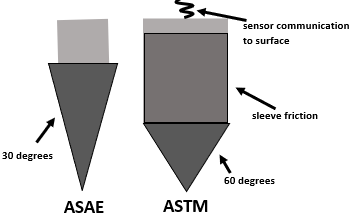The Digital Soil Core (DSC) is a 7-sensor penetrometer. We will write about each sensor over time, but the best place to start is at the bottom.
I left the geotechnical site investigation industry in 1997 in order to pursue the idea that the penetrometer sensors used to delineate deep stratigraphy could be miniaturized to assess near-surface soil profiles rapidly versus the traditional approach of taking cores or digging pits. It’s not otherwise practical to overcome the statistical threshold of the number of profile observations needed across huge fields to make a true soil map with spatial and statistical accuracy in 3D.
When I started my research, I quickly discovered that the American Society of Agricultural Engineers (ASAE) specification for penetrometers varied tremendously from the American Society of Testing and Materials (ASTM) specification. The ASAE penetrometer has one measurement (tip force) using a 30-degree angle vs the ASTM specification that utilizes a 60-degree tip. The ASTM measurement is obtained ‘downhole’ meaning the force measurement is isolated to the surface area of the tip (cone index). The 30-degree tip is designed to emulate root penetrability while the 60-degree tip is designed to distinguish better between varying stratigraphic layers.
The ASAE measurement is taken ‘uphole’. The ASAE specification assumes that, because the rod used to insert the tip into the soil has a smaller diameter, that no friction occurs along the rod as it is inserted. If it did, then the measurement above would be a function of both force on the tip and friction along the rod. In reality, and in practice, there is always friction along the rod meaning the uphole measurement is unable to discern the source of the force.
Another major difference is that the ASTM specification contains a sleeve sensor that measures friction, also downhole. This additional sensor enables the tool to distinguish between the differing cohesive properties of the soil. This allows the tool to differentiate between an increase in force between a soil with more clay versus a soil with more sand. Is the cone index high because of a change in density or texture? The ASTM specification can tell the difference.
I spent years, and many thousands of tests, to understand the relationship between the sensors and spent a great deal of time comparing the two specifications. After receiving my ‘post hole digger’ (PhD) I worked to include a moisture sensor into the penetrometer as the moisture content has a huge impact on the physics of the sensor response. This addition drastically improved the ability of the penetrometer to estimate soil texture and bulk density as well as the delineation of subtle changes in stratigraphy.
Our first technology was developed and commercially deployed and was called the Soil Information System (SIS). We licensed this technology to John Deere (2003-2007) and later sold it to Trimble in 2013. The SIS probe has a moisture sensor, but that sensor is located well up the side of the probe and is not proximate to the tip and sleeve measurement. This made it much more difficult to assess the soil moisture at the point of contact between the tip and sleeve and the soil. In addition, we were not able to measure the soil moisture to the full depth of the penetration. It was good, but improvements were needed.
The DSC represents the ‘next generation’ of multiple-sensor penetrometer as the SIS probe was developed 20 years ago. We’ve added our moisture (and a salinity) sensor to the tip which solves both the proximity and the depth of moisture measurement problem. We’ve also added many more sensors. More on the other sensors in subsequent articles.
The ability to assess the complete soil profile is critical to building a true digital twin of the crop growing environment. The DSC adds many more spatial and information dimensions to work with for machine learning and decision-support applications and is used in close conjunction with LandScan’s unparalleled Digital Vegetation Signature (DVS) technology. This combination creates a unique understanding between the relationship of a plant’s performance and behavior and the growing environment. Both the DSC and DVS are important parts of the Platform for Discovery.

